There are 41 different tzpes of snakes in Missouri including a vareity lik the Worm Snake, Coachwhips, Hog-nosed snakes, kingsnakes and more. The state is close to the top of the list of U.S. states ranked by the number of snake species.
With rivers and lakes, plains, prairies, mountains, swamps, and a humid continental and humid subtropical climate, the Cave State, as some call it, has the right conditions for various reptiles to call it home.
Among the forty-something species and subspecies of snakes in Missouri, only six of them are venomous. Most others are considered harmless, although some non-venomous species can still inflict a nasty bite. Want to know more about snake species in Missouri and what to do if you come across one? Then let’s dive right into it!
Table of Contents
Snakes in Missouri
1. Western Worm Snake
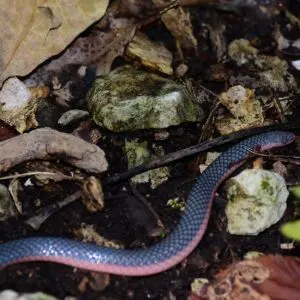
- Experience Level: Beginner
- Family: Colubridae
- Scientific Name: Carphophis vermis
- Other Names: Western wormsnake
- Adult Size: 7.5-11in
- Lifespan: 4 years
- Price Range: $20
Despite its name, it’s not too likely that you’d confuse the western worm snake with an actual worm. The species is two-colored, with a dark backside (usually black, sometimes with a purple tint) and a lighter underside, which is usually salmon-pink. The head is rounded and flat, which makes burrowing easier.
Unlike actual worms, the western worm snake doesn’t have a rounded tail. Actually, its tail has a spike which also serves as a burrowing tool. When handled, it will use the tail to defend itself, but this spike is too small to cause any harm to humans.
Another defense mechanism the species has is a foul smell it releases when it feels threatened. They almost exclusively feed on earthworms, although some research suggests that they also feed on soft-bodied species of insects.
2. Scarlet Snake
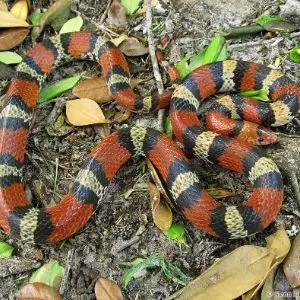
- Experience Level: Beginner
- Family: Colubridae
- Scientific Name: Cemophora coccinea
- Other Names: N/A
- Adult Size: 14-24in
- Lifespan: 10-15 years
- Price Range: $50-$80
The scarlet snake is recognizable by its tri-color pattern consisting of a white or gray base and red blotches outlined by black stripes. Often, these blotches extend to the sides, which makes it easy to confuse the species with the scarlet king snake or the coral snake.
Unlike the coral snake, however, this is a non-venomous species. It feeds on lizards, rodents, and sometimes even other snakes. It also often eats the eggs of these animals. It uses its sharp teeth to break the egg open, but will sometimes eat smaller eggs whole. Predators of the scarlet snake include other snake species (such as the coral snake), as well as mammals and birds of prey.
There are two subspecies of scarlet snakes, only one of which, the northern scarlet snake (Cemophora coccinea copei) lives in Missouri. It inhabits only a handful of small areas in the central and southern parts of the state.
3. Kirtland’s Snake
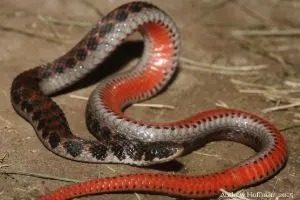
- Experience Level: N/A
- Family: Colubridae
- Scientific Name: Clonophis kirtlandii
- Other Names: Cora Kennicott’s snake, little red snake, spread head
- Adult Size: 12-18in
- Lifespan: 5 years
- Price Range: N/A
Kirtland’s snake is of a reddish-brown color with a regular pattern of large dark blotches down its back and smaller dark blotches on its sides. The underside is brick-red and bordered by a series of dark gray dots on each side. The vividly-colored belly makes the species easily distinguishable.
The species inhabits damp areas, usually around marshes. It can also be found near rivers and other bodies of water. There, it feeds on earthworms, slugs, frogs, and fish. In Missouri, this species only inhabits a small area around the Mississippi River.
Kirtland’s snake is a pretty rare find and it only inhabits only a handful of midwestern and southern states, all of which have classified it as endangered or threatened. The major issue the species is facing is the loss of habitat, mostly due to urban development and pollution.
4. Eastern Racer
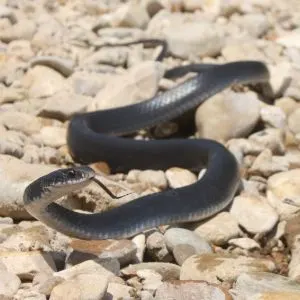
- Experience Level: Expert
- Family: Colubridae
- Scientific Name: Coluber constrictor
- Other Names: N/A
- Adult Size: 20-60 in
- Lifespan: 10 years
- Price Range: $30-$40
As you may have guessed, eastern racers are quick snakes. They are active during the day, very curious, and quite agile. Not only are they fast on land, but some species are also excellent climbers.
The eastern racer feeds on rodents, lizards, frogs, as well as other snakes. When they’re young, they will also often eat insects. Despite what its scientific name suggests, the eastern racer doesn’t actually constrict its prey but rather pins it down.
The coloration of this snake varies greatly among subspecies. The eastern yellow-bellied racer (Coluber constrictor flaviventris), one of the two subspecies that inhabits Missouri, is olive-green to grey with a yellow belly. As juveniles, however, they are usually tan or cream with darker blotches.
The other eastern racer subspecies that inhabits Missouri is the southern black racer (Coluber constrictor priapus). It is of a black to dark-gray color, while the belly is white or cream, as is the chin.
5. Coachwhip

- Experience Level: Expert
- Family: Colubridae
- Scientific Name: Coluber flagellum (Masticophis flagellum)
- Other Names: whipsnake
- Adult Size: 50-72in
- Lifespan: 15 years
- Price Range: $50-$100
The coachwhip is a long and thin snake whose body resembles a whip. In fact, this is one of the longest snake species in Missouri. It can move very quickly and basically goes into panic mode when handled. Because of this, there is a myth that coachwhips can whip a person to death. This, of course, isn’t true, although it will most likely try to bite in defense.
The subspecies found in Missouri is known as the eastern coachwhip (Masticophis flagellum flagellum), and it can be found in most of the southern half of the state. It prefers sandy areas and rocky areas and can commonly be found near marshes and swamps.
The eastern coachwhip usually has a black head and neck, which slowly fade into a tan shade further down its body. In some individuals, however, the head and neck are also tan, which makes it somewhat difficult to identify the species.
6. Ring-Necked Snake
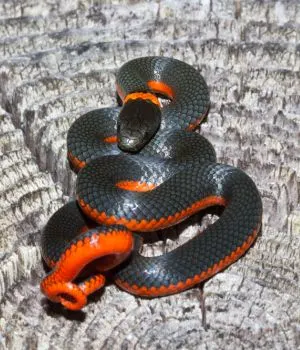
- Experience Level: Intermediate
- Family: Colubridae
- Scientific Name: Diadophis punctatus
- Other Names: ringneck snake
- Adult Size: 10-15 in
- Lifespan: 20 years
- Price Range: $30
The ring-necked snake is a unique species easily recognizable by the necklace-like band of light color around its neck. What makes the species pop out even more is its underside, which is vividly colored, usually yellow to red.
The brightly-colored belly is for more than just esthetic purposes – it’s a defense mechanism. In nature, bright colors usually mean that the animal is venomous, so this is a warning sign to predators to stay away. If the snake feels threatened, it will coil up and reveal its belly.
However, the ring-necked snake doesn’t necessarily walk the talk (no pun intended). Although it technically is venomous, the venom is rarely used on predators – it mostly serves a feeding purpose.
The subspecies of ring-necked snake that inhabits Missouri are the prairie ring-necked snake (Diadophis punctatus arnyi) and the Mississippi ring-necked snake (Diadophis punctatus stictogenys). The former can be found in northern parts of the state, while the latter is more common in southern parts.
7. Mudsnake
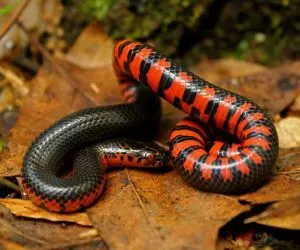
- Experience Level: Expert
- Family: Colubridae
- Scientific Name: Farancia abacura
- Other Names: hoop snake
- Adult Size: 40-54 in
- Lifespan: 19 years (in captivity)
- Price Range: $90
The mudsnake usually inhabits areas around swamps where there is a lot of mud. In Missouri, its habitat is concentrated around the southeastern corner of the state. The subspecies that inhabits Missouri is known as the western mudsnake (Farancia abacura reinwardtii).
The mudsnake is also locally known as the hoop snake. This name comes from a belief that it can bite its tail to create a hoop and roll around like a wheel. This myth is also often associated with the coachwhip. Needless to say, neither species can actually do this.
Much like ring-necked snakes, mudsnakes are dark (usually black) on their backside and brightly colored on their underside. However, unlike the ring-necked snakes, the delineation between the two colors isn’t straight but rather resembles a zig-zag pattern. Also, the belly is not unicolored but has black bands.
8. Western Hog-Nosed Snake
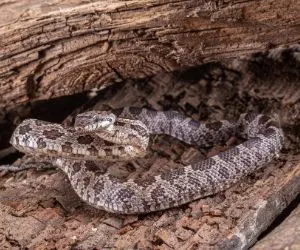
- Experience Level: Beginner to Intermediate
- Family: Colubridae
- Scientific Name: Heterodon nasicus
- Other Names: western hognose snake, blow snake, bluffer, faux viper
- Adult Size: 15-20 in
- Lifespan: 9-19 years
- Price Range: $150
The hog-nosed snake is a non-venomous species, although they don’t always act that way. When they feel threatened, they will flatten their neck (like a cobra) and hiss. If that doesn’t work, they will pretend to attack (without even opening their mouths – they’re not the best actors in the world).
If you think that biting must be their last resort, you’re wrong. This species almost never bites. As a last-resort defense mechanism, the hog-nosed snake will play dead.
The species has an upturned snout, which it uses to dig for prey. It feeds mostly on toads, frogs, and lizards, which it subdues using a toxin in its saliva. This toxin is not harmful to humans, and many scientists don’t even consider it venom.
Missouri is home to two subspecies of the hog-nosed snake. One is Gloyd’s hog-nosed snake (Heterodon nasicus gloydi), named after herpetologist Howard Gloyd. In Missouri, this species is also called the dusty hog-nosed snake. It can be found in a small area in the southeast of the state.
The other one is the plains hog-nosed snake (Heterodon nasicus nasicus), which is believed to inhabit the northwestern part of the state, although it has been years since the last sighting.
9. Eastern Hog-Nosed Snake
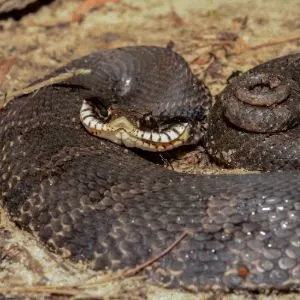
- Experience Level: Beginner
- Family: Colubridae
- Scientific Name: Heterodon platirhinos
- Other Names: spreading adder, deaf adder
- Adult Size: 28 in
- Lifespan: 12 years
- Price Range: $120-200
Much like its western cousin, the eastern hog-nosed snake has a slightly upturned snout that serves as a shovel when burrowing. This is a pretty thick snake given its length, and it has a flat and wide head. The coloration and pattern vary quite a bit depending on the location.
Although some consider the species non-venomous, this isn’t exactly true. While the venom that the eastern hog-nosed snake is harmless to humans, it is pretty effective on amphibians, which constitute the majority of its diet. In humans, it might only cause slight discomfort and swelling if the person happens to be allergic.
10. Prairie Kingsnake

- Experience Level: Intermediate
- Family: Colubridae
- Scientific Name: Lampropeltis calligaster
- Other Names: yellow-bellied kingsnake
- Adult Size: 20-40 in
- Lifespan: 15-25 years
- Price Range: $50-$200
Kingsnakes are known as the genus that not only feeds on other snakes but is actually immune to most snake venom. They also feed on other reptiles, as well as rodents and frogs.
They are non-venomous, but when they feel threatened, they will imitate the behavior of a rattlesnake by “rattling” their tails against dry foliage.
The prairie kingsnake is usually brown to gray with darker blotches. Despite the fact that its other common name is the yellow-bellied kingsnake, the belly of this species isn’t necessarily yellow – it is closer to tan or cream-colored.
The species is generally quite secretive. Although its geographical range is pretty wide (in Missouri, it can be found almost anywhere), it is unlikely you’ll run into it unless you’re looking for it. It is a common guest in abandoned buildings.
11. Speckled Kingsnake
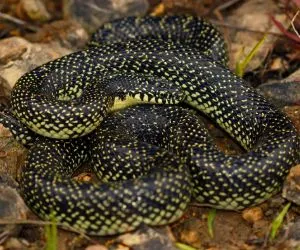
- Experience Level: Beginner to Intermediate
- Family: Colubridae
- Scientific Name: Lampropeltis holbrooki
- Other Names: Salt and pepper snake
- Adult Size: 36-48 in
- Lifespan: 20 years
- Price Range: $100-$200
The speckled kingsnake is usually black with a tiny white spot on almost every scale on its back. This coloration also earned it its other common name – salt and pepper snake. The belly is usually whitish to yellow, with scattered black specks on the sides.
The species isn’t too picky when it comes to habitats, although it does prefer wetter environments than most other kingsnakes. In Missouri, it can be found throughout the state. It is most commonly encountered near swamps, rivers, and other bodies of water.
Although the speckled kingsnake is generally considered docile, it won’t refrain from biting if it feels threatened. Even so, they are relatively common pets, as they’re not too difficult to care for.
12. Milksnake
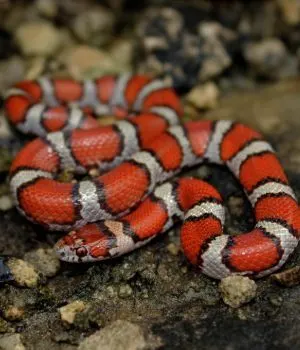
- Experience Level: Beginner
- Family: Colubridae
- Scientific Name: Lampropeltis triangulum
- Other Names: N/A
- Adult Size: 24in
- Lifespan: 12-20 years
- Price Range: $90-$170
Milksnakes and kingsnakes are close cousins. This species got its name after a common myth that they drink the milk of cows and other farm animals.
This story probably originated from the fact that they are commonly encountered on farms and in stables. The myth is, of course, entirely false. Rather than cow milk, milksnakes feed on lizards, birds, rodents, and other, smaller snakes.
The species is usually tricolored, with alternating bands of red, black, and white. They can look quite similar to the venomous coral snake.
This is hardly a coincidence – it is actually a defense mechanism meant to deter predators. Because of the uncanny resemblance, people have developed rhymes to make distinguishing them easier: Red on yellow kill a fellow. Red on black venom lack.
There are two subspecies of milksnake in Missouri, the red milksnake (Lampropeltis triangulum syspila) and the eastern milksnake (Lampropeltis triangulum triangulum). Both are commonly found throughout the state.
13. Black Kingsnake
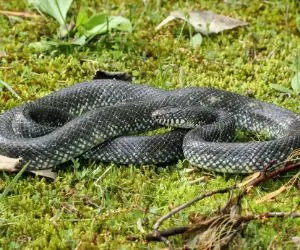
- Experience Level: Beginner
- Family: Colubridae
- Scientific Name: Lampropeltis nigra
- Other Names: eastern black kingsnake
- Adult Size: 35-48 in
- Lifespan: 15-25 years
- Price Range: $100-$300
Unlike most of its kingsnake relatives, the black kingsnake isn’t heavily patterned. At first glance, it appears unicolored (usually black or a very dark shade of brown). However, if you look closer, you will notice a series of small lightly colored (white, cream, or tan) specks. These aren’t as dense as those of the speckled kingsnake.
The black kingsnake is a very commonly encountered species. It can adapt to a wide range of habitats, although it usually prefers to stay near water. It’s not an uncommon guest on farms and in abandoned structures. In Missouri, its habitat is limited to the southeast of the state, near the Mississippi River.
Black kingsnakes are considered a good choice of pet for beginners. They usually don’t react aggressively to being handled (although juveniles might be a little temperamental) and aren’t picky eaters (they usually eat rodents, lizards, and other snakes).
14. Plain-Bellied Watersnake
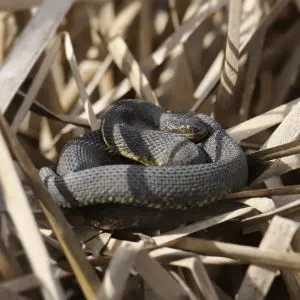
- Experience Level: Intermediate
- Family: Colubridae
- Scientific Name: Nerodia erythrogaster
- Other Names: plainbelly watersnake
- Adult Size: 24-40 in
- Lifespan: 8-15 years (in captivity)
- Price Range: $20-$80
The first watersnake on our list is the plain-bellied watersnake. This is typically a black, dark brown, or dark gray species and a unicolored belly that ranges from pink to white. As the name suggests, there are no patterns on the belly.
As you have probably guessed, the species is found exclusively near (and in) bodies of water. In Missouri, this includes the eastern, southern, and western parts of the state.
The plain-bellied watersnake is mostly aquatic, although it does leave the water quite often to bask. They sometimes feed on land, too.
On land, the plain-bellied watersnake can fall prey to other snakes (kingsnakes, we’re looking at you), hawks, and other birds of prey. However, water is not a much safer environment, either, as some large species of bass feed on plain-bellied watersnakes.
15. Banded Watersnake
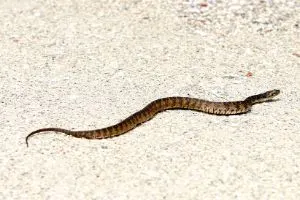
- Experience Level: Intermediate
- Family: Colubridae
- Scientific Name: Nerodia fasciata
- Other Names: southern watersnake
- Adult Size: 24-42 in
- Lifespan: 8 years
- Price Range: $20-$50
The second aquatic snake on our list is the banded watersnake. This is a heavy-bodied species with dark bands in zig-zag patterns. The coloration varies from grayish tones to orange-brown shades, while some specimens can be so dark that they appear patternless. Its body is quite thick, and the head is flat and wide.
The banded watersnake mainly feeds on amphibians and fish. When threatened, it puffs up its head and releases a foul-smelling musk to deter the predator. If that doesn’t work, it won’t refrain from biting. Its main predators are alligators, herons, and other snakes.
The subspecies that inhabits Missouri is known as the broad-banded watersnake (Nerodia fasciata confluens). It is characterized by wide dark brown to black bands across its lightly colored brown-to-reddish body.
16. Diamond-Backed Watersnake
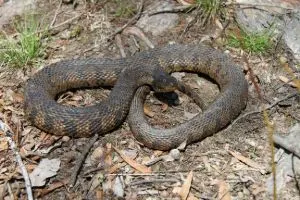
- Experience Level: Intermediate to Expert
- Family: Colubridae
- Scientific Name: Nerodia rhombifer
- Other Names: diamondback watersnake
- Adult Size: 30-48 in
- Lifespan: 10 years
- Price Range: $20-$50
Of the five watersnake species that call Missouri home, this is the biggest one. The diamondback watersnake has a distinct diamond-shaped pattern on its back, which is how it got its common name.
It is usually a shade of brown or olive in color, while the “diamonds” are slightly darker. The underside is usually of a lighter shade.
Diamondbacks have a very specific way of hunting for food. They climb low branches above the surface of the water and from there, submerge their heads.
Since it mainly feeds on fish, the diamondback watersnake has very sharp teeth meant to prevent the fish from slipping away.
Because of this, even though it’s not venomous, the bite of a diamondback hurts a lot, so it’s best not to harass it if you see one in the wild.
17. Northern Watersnake
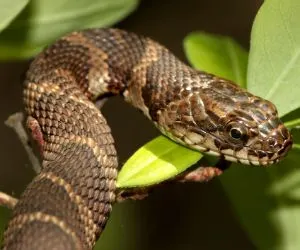
- Experience Level: Beginner to Intermediate
- Family: Colubridae
- Scientific Name: Nerodia sipedon sipedon
- Other Names: common watersnake
- Adult Size: 4ft 5in
- Lifespan: 9 years (in captivity)
- Price Range: $20-$80
The northern watersnake is the most common species of watersnake in Missouri, and it can be found throughout the state – basically anywhere where there is water. It lives near lakes, rivers, ponds, swamps, and marshes, and basks on rocks and stumps.
The common watersnake is active both during the day and at night, which gives it access to a wider range of prey. During the day, it feeds on worms, crayfish, salamanders, leeches, birds, and rodents. At night, it hunts for minnows and other small fish that it finds using its sharp sense of smell.
The northern watersnake is preyed upon by a long list of predators, including several species of larger snakes, birds of prey, raccoons, foxes, and turtles.
When threatened, the northern watersnake will defend itself with all it has, and it’s not uncommon for this species to bite.
Its saliva contains an anticoagulant, which makes it harder for a wound to stop bleeding. However, there is little chance for this to cause serious consequences to humans.
18. Green Watersnake
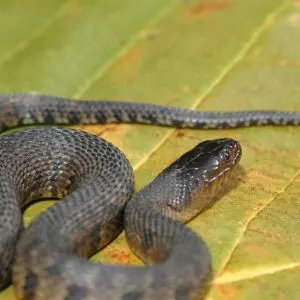
- Experience Level: Intermediate
- Family: Colubridae
- Scientific Name: Nerodia cyclopion
- Other Names: Mississippi green watersnake
- Adult Size: 30-55 in
- Lifespan: N/A
- Price Range: $20
This is a dark green to olive-green species of aquatic snake with a stout body. The belly is of a yellowish shade in the first third of the body, while the rest is darker and patterned.
The green watersnake can be distinguished from other species of watersnakes by a set of smaller scales under its eyes. The only other species that has that is the Florida green watersnake, which used to be considered a subspecies.
Like many other non-venomous species of snakes, the green watersnake’s first instinct is to flee when approached. However, if cornered, it won’t hesitate to fight for its life, and this includes biting and releasing a smelly musk. In Missouri, the species can be found in the southeastern part of the state, along the Mississippi River.
19. Rough Green Snake

- Experience Level: Beginner to Intermediate
- Family: Colubridae
- Scientific Name: Opheodrys aestivus
- Other Names: grass snake, green grass snake (not to be confused with the smooth green snake, which also has these common names)
- Adult Size: 45 in
- Lifespan: 5 years
- Price Range: $10-$30
The rough green snake is a semi-arboreal species, which means that it spends quite some time in the trees. Its long and slender body, uniform green back, and yellowish belly allow for great camouflage among the leaves and branches. There, it hunts for insects and arthropods. Occasionally, it will also eat a smaller frog or snail.
This is a very docile species that often allows humans to approach it, and even handle it. It rarely bites, and even if it does, the bites don’t contain venom and are harmless. Its peaceful nature makes the rough green snake a good pet, although some previous experience with pet snakes might be necessary.
In Missouri, the rough green snake can be found (if you look very hard) pretty much everywhere, with the exception of the northernmost counties in the state.
20. Smooth Green Snake
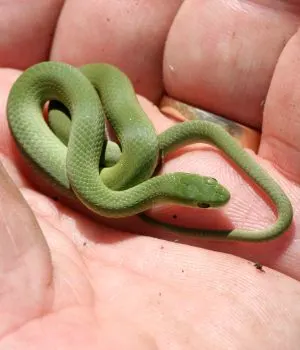
- Experience Level: Beginner to Intermediate
- Family: Colubridae
- Scientific Name: Opheodrys vernalis
- Other Names: grass snake, green grass snake
- Adult Size: 14-20 in
- Lifespan: 6 years
- Price Range: $30-$100
The smooth green snake looks very similar to its closest cousin, the rough green snake. However, there are several differences. Firstly, the smooth green snake is notably smaller – just over half the size of its rough-scaled relative.
Secondly, the scales of the smooth green snake are, well, smooth, unlike the rough green snake, which has rough scales. And thirdly, while the rough green snake is absent in northern parts of Missouri, that is precisely where the smooth green snake is most commonly found.
This species also spends a lot of its time in trees and feeds on insects. It is somewhat skittish and will likely try to flee if approached. However, it’s not too common for a smooth green snake to bite. Both of these species are preyed upon by a number of predators, including hawks, crows, larger snakes, raccoons, foxes, and other mammals.
21. Great Plains Rat Snake
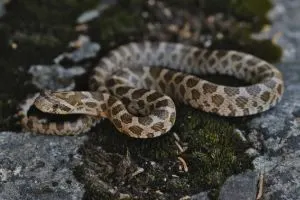
- Experience Level: Beginner
- Family: Colubridae
- Scientific Name: Pantherophis emoryi
- Other Names: chicken snake, Emory’s coluber, Emory’s pilot snake, Emory’s racer, Emoryi rat snake
- Adult Size: 3-5 ft
- Lifespan: 15-20 years
- Price Range: $70-$90
The great plains rat snake is a non-venomous species. It is usually of a tan or gray shade with gray, brown, or dark green blotches. It also has two distinct stripes on its cheeks which meet between the eyes. The species was named after Smithsonian Institute’s surveyor and collector William Emory.
Although they aren’t venomous, great plains rat snakes will imitate the behavior of venomous species when they feel threatened. They often rattle their tails against leaves and other foliage to produce a sound similar to that which a rattlesnake makes. This is a defense mechanism meant to confuse and deter predators.
Speaking of predators, adult great plains rat snakes don’t have many. As juveniles, however, they are quite vulnerable. They are often preyed upon by different species of foxes, raccoons, and birds of prey (mostly owls and hawks). Another threat they face is being killed by humans who mistake them for rattlesnakes.
22. Western Rat Snake
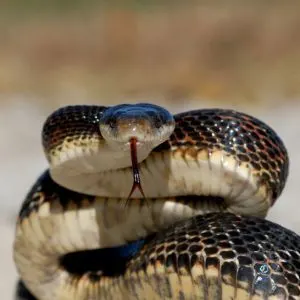
- Experience Level: Intermediate
- Family: Colubridae
- Scientific Name: Pantherophis obsoletus
- Other Names: black rat snake, pilot black snake, black snake
- Adult Size: 3-6 ft
- Lifespan: 20 years
- Price Range: $50-$100
Western rat snake adults are usually of glossy black color with a tan or cream-colored belly with brownish bands. As juveniles, however, they are much more heavily patterned.
Although this pattern disappears as they grow, it can still sometimes be discerned on the skin between the scales, especially after feeding, when the snake’s skin is stretched.
This is one of the largest snakes in Missouri, as well as on the North American continent as a whole. The longest recorded specimen measured at 8 ft 5 in. This long body comes in handy when constricting its prey, which usually consists of rodents, although the western rat snake isn’t a picky eater.
The black rat snake is a shy species, and it usually avoids confrontation. When it feels threatened, instead of fleeing or attacking, it will often completely freeze. Not a great defense mechanism if you ask us.
23. Western Fox Snake
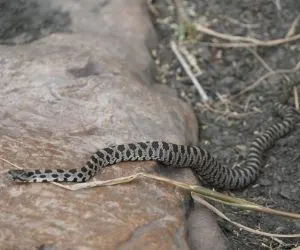
- Experience Level: Beginner to Intermediate
- Family: Colubridae
- Scientific Name: Pantherophis ramspotti
- Other Names: N/A
- Adult Size: 3-5 ft
- Lifespan: 12-20 years
- Price Range: N/A
Despite what the name suggests, the western fox snake doesn’t actually look like a fox (nor does it feed on foxes). The species is typically tan to light brown, with the ventral part lighter than the back. It has a series of large blotches of a darker brown shade.
The western fox snake is usually active during the day, although it does switch to nighttime once the weather gets too hot in the summer. It is a great swimmer and climber and isn’t afraid to strike when it feels threatened. The species lives exclusively west of the Mississippi River. In Missouri, it can be found in the northwestern corner of the state.
24. Eastern Fox Snake
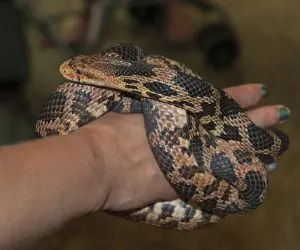
- Experience Level: Beginner to Intermediate
- Family: Colubridae
- Scientific Name: Pantherophis vulpinus
- Other Names: foxsnake, western fox snake
- Adult Size: 3-6 ft
- Lifespan: 12-20 years
- Price Range: N/A
The eastern fox snake doesn’t look like a fox, either. However, its scientific name is a play on words. Vulpinus comes from Latin and means “fox-like”, which is an homage to snake collector Charles P. Fox.
However, there is a lot of confusion regarding eastern and western fox snakes. Some scientists consider them the same species, while others see the Mississippi River as the border between the two, thus dividing them into eastern and western species.
To make things even more confusing, Pantherophis vulpinus used to be known as the western fox snake, a name which has somewhat stuck even after the reclassification, so the two species are often easily confused. Needless to say, they also look alike.
25. Gopher Snake
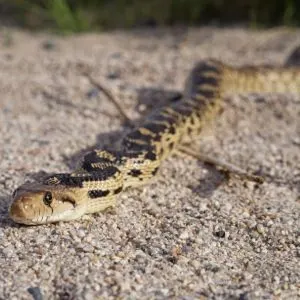
- Experience Level: Intermediate
- Family: Colubridae
- Scientific Name: Pituophis catenifer
- Other Names: N/A
- Adult Size: 36-84 in
- Lifespan: 15 years
- Price Range: $40 to $750
Gopher snakes have a distinct chain-like pattern on their backs, which is how they got their scientific name (catenifer is Latin for “chain-bearing”). The base color is usually yellow to brown, with regularly-shaped dark blotches that create a chain-like illusion.
Gopher snakes feed on small rodents, such as mice and rats, as well as birds and bird eggs. They kill the prey by constricting it since it doesn’t produce venom. However, like many other non-venomous species, the gopher snake will imitate the behavior of a rattlesnake in order to deter predators.
Pituophis catenifer sayi is the subspecies of gopher snakes that can be found in Missouri. Its common name is bullsnake, which can be somewhat confusing since a number of other species and subspecies carry the same name. The scientific subspecific name, sayi, is an homage to herpetologist Thomas Say.
26. Graham’s Crayfish Snake
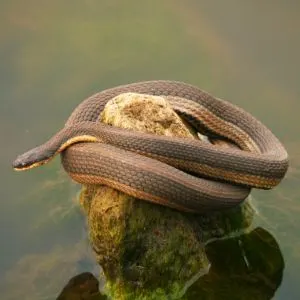
- Experience Level: Intermediate to Expert
- Family: Colubridae
- Scientific Name: Regina grahamii
- Other Names: Graham’s leather snake, Graham’s queen snake, Graham’s snake, Graham’s water snake, prairie water adder, prairie water snake, and striped moccasin
- Adult Size: 18-28in
- Lifespan: 7 years
- Price Range: $50
Graham’s crayfish snake is a semiaquatic species named after James Duncan Graham, founder of the Corps of Topographical Engineers. It is usually brown or gray and may have a light stripe in the middle of its back. The sides have a distinct stripe that is usually tan to yellow.
Since this snake prefers aquatic environments, it can be found near lakes, rivers, swamps, marshes, and streams. As the name suggests, it feeds almost exclusively on crayfish. Although it will sometimes eat other aquatic animals, it is a picky eater and typically sticks to its crayfish diet.
Graham’s crayfish snake is not an easy pet to have. If not cared for properly, it may start refusing to eat. It is also not uncommon for the species to develop skin conditions in captivity. In Missouri, this snake can be found in the northwestern half of the state, as well as along the Mississippi River.
27. Western Ground Snake
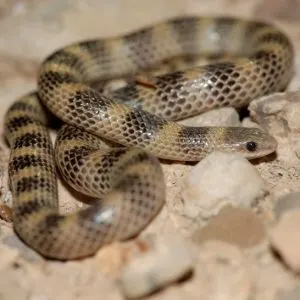
- Experience Level: Beginner
- Family: Colubridae
- Scientific Name: Sonora semiannulata
- Other Names: ground snake, common ground snake, miter snake, variable ground snake
- Adult Size: 9-18 in
- Lifespan: 15 years
- Price Range: N/A
Recognizing the western ground snake in the wild is borderline impossible. This is because the color and patterns vary greatly. They can be unicolored, banded, or striped, red, brown, or orange. This wide variety is what earned the species one of its common names – variable ground snake.
In the past, there used to be five distinct subspecies of the western ground snake (and some scientists still use this classification, although it is mostly obsolete).
However, due to a lot of geographic overlapping, these subspecies would breed among each other to the point where it has become impossible to make a distinction among them.
In Missouri, the variable ground snake inhabits the southernmost counties of the state. It feeds on scorpions, spiders, and centipedes. It is nocturnal and prefers to remain hidden under rocks or in crevices.
28. Brown Snake
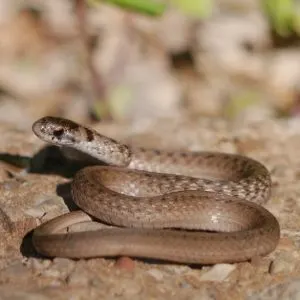
- Experience Level: Beginner
- Family: Colubridae
- Scientific Name: Storeria dekayi
- Other Names: De Kay’s snake
- Adult Size: 12in
- Lifespan: 7 years
- Price Range: 30 years
The brown snake is also known as DeKay’s snake, a name it got, along with the scientific name, after James Ellsworth De Kay, a zoologist credited with collecting the first specimen. The other part of the scientific name, Storeria, is an homage to another zoologist, David Humphreys Storer.
This is a small species, usually brown or gray with a stripe of a slightly lighter shade running down the middle of its back. The stripe is bordered by tiny dark speckles, and the belly is a lighter shade of brown. The jaws of the brown snake are adapted to de-shelling snails when feeding. It also feeds on slugs and worms.
Out of a total of seven subspecies of the brown snake, two call Missouri home – midland brown snake (Storeria dekayi wrightorum) and Texas brown snake (Storeria dekayi texana). The former can be found statewide, while the latter inhabits the western part of the state.
29. Red-Bellied Snake
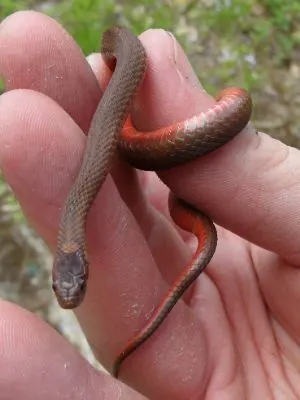
- Experience Level: Intermediate
- Family: Colubridae
- Scientific Name: Storeria occipitomaculata
- Other Names: redbelly snake
- Adult Size: 12in
- Lifespan: 2-4 years
- Price Range: $60
The red-bellied snake is a small species easily recognizable by its vividly colored belly. Although the belly can be red, as the name suggests, there are specimens with yellow and orange variations.
Dorsally, the snake is darker in color, usually brown or reddish, and it may have four or five faint stripes. It also has spots around its neck that may morph together to form a collar.
The red-bellied snake is known for “lip-curling”. Basically, when threatened or when attacking prey, the snake will bare its teeth, much like an angry dog.
This is a behavior it often exhibits when handled. If that doesn’t work, the snake will also “rub” its teeth against the handler’s skin as a warning sign. However, due to the red-bellied snake’s small size, it can’t really harm a human.
The subspecies that calls Missouri home is the northern red-bellied snake (Storeria occipitomaculata occipitomaculata).
30. Flat-Headed Snake

- Experience Level: Intermediate
- Family: Colubridae
- Scientific Name: Tantilla gracilis
- Other Names: flathead snake
- Adult Size: 7-8 in
- Lifespan: 4 years
- Price Range: N/A
The flat-headed snake is the smallest snake species in Missouri. It is usually a shade of tan or brown with a lighter, salmon-colored underside. The flat and rounded head can be slightly darker than the rest of the body.
This tiny snake mostly feeds on centipedes and larvae. It prefers moist environments with plenty of rocks to hide under during the day. In Missouri, it can be found in the southern half of the state, with the exception of the southeastern corner.
The species is usually active from spring to late fall. Females lay 1-4 eggs in spring, which usually hatch in August and September. When it hatches, the flat-headed snake is only three inches long!
31. Western Ribbon Snake
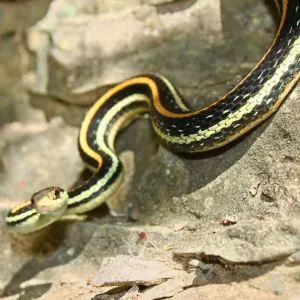
- Experience Level: Beginner
- Family: Colubridae
- Scientific Name: Thamnophis proximus
- Other Names: N/A
- Adult Size: 17-15in
- Lifespan: 3-6 years in the wild, 12-20 years in captivity
- Price Range: $20-$50
Yet another tiny snake species, the western ribbon snake is slender and dark in color, usually black or brown. It has three brightly colored stripes running from its back to the end of its tail.
The underside is usually a shade of cream and may have a green tint. Although hatchlings are, naturally, smaller than adults, they have disproportionately large heads that they grow into with time.
Western ribbon snakes prefer habitats with lots of brush and bodies of water (which makes sense, since this is a semi-aquatic species). It often flees underwater when threatened. In Missouri, the species can be found statewide. The subspecies that lives in Missouri is known as the orange-striped ribbon snake (Thamnophis proximus proximus).
32. Plains Garter Snake
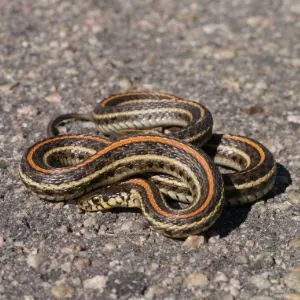
- Experience Level: Beginner
- Family: Colubridae
- Scientific Name: Thamnophis radix
- Other Names: N/A
- Adult Size: 3ft
- Lifespan: 8 years in captivity
- Price Range: $20-$300
The plains garter snake is the western ribbon snake’s close cousin, and you can tell just by looking at them. Much like the ribbon snake, the plains garter snake has a dark, often black base color and three orange to yellow stripes running along its back. However, aside from being larger, the plains garter snake also has a checkered pattern all over its back.
Plains garter snakes are known for being able to tolerate cooler temperatures than most other species they share their habitat with. Sometimes, they will even come out of hibernation in winter to bask on somewhat warmer winter days. For the most part, however, they are active in spring and summer.
The plains garter snake usually lives in meadows and prairies and is almost exclusively found near bodies of water. In Missouri, its habitat includes the northwestern portion of the state. There is also an isolated population in the central-eastern region.
33. Common Garter Snake
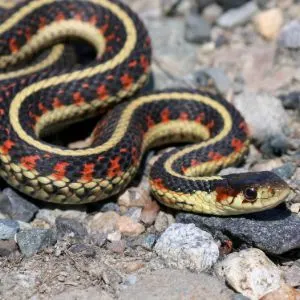
- Experience Level: Beginner
- Family: Colubridae
- Scientific Name: Thamnophis sirtalis
- Other Names: N/A
- Adult Size: 18-54 in
- Lifespan: 2 years in the wild, 6-10 years in captivity
- Price Range: $25-$100
The common garter snake is the most common Thamnophis in Missouri. It can be found statewide. In the eastern part of the state, you are more likely to encounter the subspecies known as the eastern garter snake (Thamnophis sirtalis sirtalis). In western and northern regions, the more common subspecies is the red-sided garter snake (Thamnophis sirtalis parietalis).
Common garter snakes are fairly thin and vary greatly in coloration – from olive-green to golden to black. Like their two previously-listed cousins, they have three lighter-colored stripes running down their backs.
The common garter snake is diurnal and active in warmer months. It usually hibernates between October and April. They usually hibernate in crevices, under rocks and stumps, or in burrows. This isn’t a solitary species – they hibernate in groups in order to prevent a big drop in body temperature.
34. Lined Snake
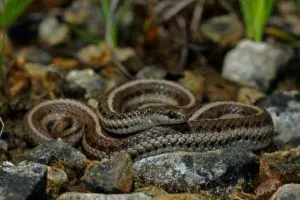
- Experience Level: Beginner to Intermediate
- Family: Colubridae
- Scientific Name: Tropidoclonion lineatum
- Other Names: common snake, dwarf garter snake, grass snake, line snake, ribbon snake, streaked snake, striped snake, and swamp snake
- Adult Size: 8-15 in
- Lifespan: 3-10 years (presumed)
- Price Range: $100
The lined snake is the only representative of the Tropidoclonion genus. The slender and small species come in a variety of colors usually ranging from olive-green to brown. It has a light stripe running down the middle of its back, as well as two additional stripes on the sides, which are bordered by thin dark stripes.
The lined snake spends a lot of time hiding under rocks, logs, and foliage or in burrows. They usually come out after heavy rains and generally avoid scorching hot weather (even though they spend winters hibernating). They feed mostly on earthworms, but may also feed on some insects, snails, and slugs.
Due to an increased loss of habitat as a result of urban development, lined snakes are becoming a more and more common guest in residential areas. Luckily, they are nonvenomous and generally not too aggressive (although they might try to bite if picked up). Unfortunately, they also often end up as roadkill.
35. Rough Earth Snake
- Experience Level: N/A
- Family: Colubridae
- Scientific Name: Haldea striatula (formerly: Virginia striatula)
- Other Names: brown ground snake, ground snake, little brown snake, little striped snake, small brown viper, small-eyed brown snake, southern ground snake, striated viper, worm snake
- Adult Size: 7-10in
- Lifespan: 7 years
- Price Range: N/A
The rough earth snake is a small, glossy snake, usually brown with a tan belly. Some specimens have a faint lightly-colored ring around the neck. The head is small and rounded, and the snout is pointed. Its dorsal scales are keeled, which gives it the name rough earth snake.
This is a skittish, shy, and generally harmless snake. It is non-venomous and unlikely to bite, even if picked up. When harassed, it is much more likely to stay completely motionless or attempt to flee. The only real defense mechanism this snake has is a foul smell it releases when threatened.
The rough earth snake feeds on worms, slugs, insects, insect eggs, and larvae. Since it’s non-venomous, you’d assume it would have another way of subduing prey, such as constriction. However, the rough earth snake simply eats its prey without subduing it.
36. Smooth Earth Snake
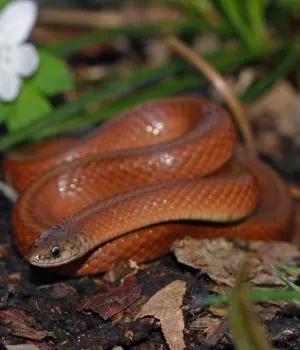
- Experience Level: N/A
- Family: Colubridae
- Scientific Name: Virginia valeriae
- Other Names: smooth earthsnake
- Adult Size: 7-10in
- Lifespan: 9 years
- Price Range: N/A
Much like there are both rough and smooth green snakes, the rough earth snake also has its smooth counterpart. Both species are of a brownish color, but, as you may have guessed, the smooth earth snake has smooth scales.
Earth snakes are largely fossorial species, which means they spend a lot of their time burrowing or hidden underneath rocks, stumps, foliage, or inside crevices. The brown coloration provides pretty effective camouflage in such environments, making it harder for predators to find them.
There are three subspecies of the smooth earth snake. The one that lives in Missouri is known as the western smooth earth snake (Virginia valeriae elegans). It can be found throughout the state although it is most common in southern regions.
37. Eastern Copperhead
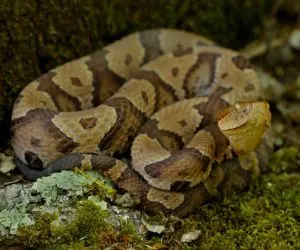
- Experience Level: Expert
- Family: Viperidae
- Scientific Name: Agkistrodon contortrix
- Other Names: copperhead
- Adult Size: 20-37in
- Lifespan: 15 years in the wild, 23 years in captivity
- Price Range: $100
And so we have come to the first venomous snake on our list, as well as the first snake belonging to a family other than Colubridae. Copperheads are venomous pit vipers common in many areas throughout North America.
The eastern copperhead is a stout snake with a tan or light-brown base color with crossbands that are light-brown in the center and dark-brown towards the edges. The belly is usually the same shade as the base color on the back.
The eastern copperhead isn’t skittish. When approached, rather than flee, they will stand their ground (most likely relying on their camouflage to keep them hidden).
They are generally not aggressive unless they genuinely feel threatened. They usually only bite if touched, and even then, they will first inflict a venom-free warning bite. If you ask us, however, it’s better not to test them.
The subspecies of the eastern copperhead that lives in Missouri is the Osage copperhead (Agkistrodon contortrix phaeogaster). It can be found pretty much statewide, with the exception of a small area along the northern border.
38. Cottonmouth
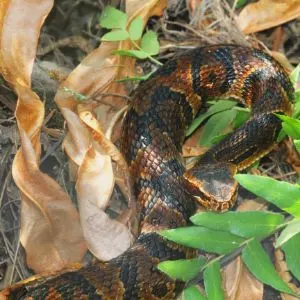
- Experience Level: Expert
- Family: Viperdiae
- Scientific Name: Agkistrodon piscivorus
- Other Names: northern cottonmouth, water moccasin, swamp moccasin, black moccasin
- Adult Size: 31in
- Lifespan: 20 years
- Price Range: $150
Copperhead’s close cousins, cottonmouths are the largest of the Agkistrodon genus. They are patterned with irregular blotches, and color schemes can vary anywhere from tan to dark brown and almost completely black.
When approached, there is basically no telling whether the cottonmouth will try to escape or stand its ground and display warning signs.
However, it is rare for the cottonmouth to actually bite if not touched or picked up. As a warning sign, the snake will assume an s-shaped position with the front half of its body, hiss, and open its mouth wide to expose the white interior (hence the name cottonmouth).
Western Cottonmouth (Agkistrodon piscivorus leucostoma) is the subspecies found in Missouri. It can mainly be found in the southern half of the state. Even though it’s not too aggressive, this is a venomous snake, so if you happen to stumble upon one in the wild, it’s best to stay away.
39. Timber Rattlesnake
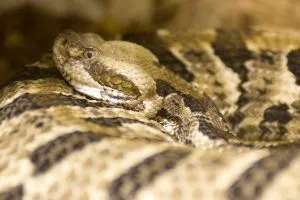
- Experience Level: Expert
- Family: Viperidae
- Scientific Name: Crotalus horridus
- Other Names: canebrake rattlesnake, banded rattlesnake
- Adult Size: 36-60in
- Lifespan: 30 years
- Price Range: N/A
Timber rattlesnakes are yellowish-brown or gray rattlesnakes with a brown or black crossband pattern. The belly is usually tan to yellow and either patternless or with black blotches. The scales are keeled.
Timber rattlesnakes are active during the warmer part of the year. In winter, they brumate (a reptile version of hibernation) in crevices. It is not uncommon for them to brumate with other snakes, often even other snake species (copperheads and rat snakes) to ensure they maintain the temperature necessary for survival.
Rattlesnakes play an important part in the ecosystem – one that is even beneficial to humans. Since they mostly feed on small mammals, they are crucial for keeping the rodent population in check.
The timber rattlesnake produces a lot of venom, making it one of the most dangerous species on the continent. Luckily, it is not too likely to attack humans unless picked up or touched.
40. Massasauga Rattlesnake

- Experience Level: Expert
- Family: Viperidae
- Scientific Name: Sistrurus catenatus
- Other Names: massasauga, massasauga rattler, gray rattlesnake, swamp rattler
- Adult Size: 24-30in
- Lifespan: 20 years (in captivity)
- Price Range: $100
Massasauga rattlesnakes are stout-bodied and have dark, irregularly shaped blotches on a grayish background. The tail is covered in dark stripes. This pattern and color combination allows them to blend into the background, which can make them hard to spot.
Massasauga’s venom has cytotoxic properties, which means that it attacks cells. It also prevents the blood from clotting, which can make healing difficult. In small mammals, which are the staple of massasauga’s diet, this causes severe internal bleeding and, eventually, death.
Two Massasauga subspecies are known to call Missouri home. Eastern massasauga (Sistrurus catenatus catenatus) is believed to inhabit the northeastern part of the state, along the Mississippi River, although it hasn’t been spotted in a while. The other subspecies is the western massasauga (Sistrurus catenatus tergeminus), which is still present in the state, although in very low numbers.
41. Pygmy Rattlesnake

- Experience Level: Expert
- Family: Viperidae
- Scientific Name: Sistrurus miliarius
- Other Names: ground rattlesnake, hog-nosed rattlesnake, little rattlesnake, miliary rattlesnake
- Adult Size: 16-24in
- Lifespan: 16 years (in captivity)
- Price Range: $120
The pygmy rattlesnake is a small rattlesnake species – even its rattle is smaller than in other rattlesnakes. The rattle lacks the free segment, which causes it to produce a buzz-like sound, rather than a rattling sound. Color patterns of the pygmy rattlesnake vary from black to light pink, depending on the location.
While the pygmy rattlesnake’s rattle isn’t as effective in producing noise, it does serve other purposes. Namely, the pygmy rattlesnake uses a hunting technique called caudal luring. Using its tail, it imitates other animals that its prey may want to eat – earthworms or insects. This tricks frogs, lizards, and other snakes into thinking they’re about to land a meal, only to become one themselves.
The subspecies of the pygmy rattlesnake seen in Missouri is the western pygmy rattlesnake (Sistrurus miliarius streckeri). It can be found in the south of the state, along the border with Arkansas.
Wrapping up
The state of Missouri is home to a rich and diverse ecosystem that includes dozens of snake species and subspecies. Although only a handful of them are venomous, there are often a lot of inter-species resemblances, making it difficult to discern between various snakes, especially to an untrained eye. If you ever run into a snake in the wild and aren’t sure what species it is (or even if you think you know), it’s best to leave it alone.
Snakes are beautiful, majestic creatures, but they have developed dangerous defense mechanisms that have earned them somewhat of a negative reputation. Although they deserve appreciation and admiration as much as any other creature under the sun, unless you have been trained to handle them, it is best to marvel at them from a safe distance.
Snakes in other states
- Snakes in Arkansas
- Snakes in Illinois
- Snakes in Iowa
- Snakes in Kansas
- Snakes in Kentucky
- Snakes in Nebraska
- Snakes in Oklahoma
- Snakes in Tennessee
Resources:
https://mdc.mo.gov/sites/default/files/mo_nature/downloads/page/MissouriSnakes.pdf
https://fisheries.tamu.edu/files/2013/10/Snakes-of-Missouri.pdf
https://www.fs.usda.gov/Internet/FSE_DOCUMENTS/fsm9_012483.pdf
